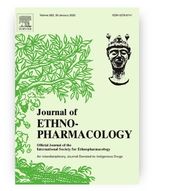Ethnodermatological use of medicinal plants in India: From ayurvedic formulations to clinical perspectives – A review
Uttpal Anand, Champa Keeya Tudu, Samapika Nandy, Kumari Sunita, Vijay Tripathi, Gary J. Loake, Abhijit Dey, Jarosław Proćków
Journal of Ethnopharmacology
Ministerial score = 140.0
JIF Impact Factor (2020) = 4.360
 Ethnopharmacological relevance Traditional knowledge is a particular form of practice or skill set that was developed in ancient times and was sustained through generations via the passing of knowledge, essentially confined within a specific tribe, local people, or family lineages. Ethnodermatological use of medicinal plants in India is still a subject to conduct more studies to see if there is chemical, microbiological, and/or clinical evidence, from a scientific perspective, of their effectiveness for those skin disorders. Thus, this review can be the basis for further studies and may provide targets for drug development. Aim of the study We compile and emphasize the most important part of ethnodermatology, namely, traditional knowledge of medicinal plants and their applications for several skin diseases in India. We also include a brief review and explanation on dermatology in Ayurvedic and Unani medicine. We review the pharmacological activity of extracts derived from some of the most cited plants against problem skin diseases as well. Materials and methods Different kinds of key phrases such as “Indian traditional ethnodermatology”, “ethnodermatology”, “ethnobotany”, “skin diseases”, “Ayurveda dermatology”, “pharmacological activity” were searched in online search servers/databases such as Google Scholar (https://scholar.google.com/), ResearchGate (https://www.researchgate.net/), PubMed (https://pubmed.ncbi.nlm.nih.gov/), NISCAIR Online Periodicals Repository (NOPR) (http://nopr.niscair.res.in/). Based upon the analyses of data obtained from 178 articles, we formulated several important findings which are a summary shown in Tables. Tables. A total of 119 records of plants’ uses have been found across India against 39 skin diseases. These are depicted with their localities of report, parts used, and preparation and administration methods against particular skin diseases. Results The knowledge and utilisation of herbal medicine in the Indian subcontinent has great potential to treat different kinds of human skin disorders. The administration of extracts from most of the plant species used is topical and few only are administrated orally. We also investigated the pharmacological activity of the extracts of the most cited plants against mice, bacterial and fungal pathogens, and human cells. Conclusions Complementary therapy for dermatological problems and treatment remains the main option for millions of people in the Indian subcontinent. This review on the practices of ethnobotanical dermatology in India confirms the belief that their analysis will accelerate the discovery of new, effective therapeutic agents for skin diseases. However, more studies and clinical evidence are still required to determine if the identified species may contribute to skin condition treatment, particularly in atopic eczema. Today, ethnodermatology is a well-accepted international discipline and many new practices have been initiated in numerous countries. We hope this article will further accelerate the development of this area to identify a new generation of natural human skin treatments that will help meet the growing consumer demand for safe, sustainable, and natural treatments. In this context, research on plants utilised in ethnodermatology in India and elsewhere should be intensified.
Ethnopharmacological relevance Traditional knowledge is a particular form of practice or skill set that was developed in ancient times and was sustained through generations via the passing of knowledge, essentially confined within a specific tribe, local people, or family lineages. Ethnodermatological use of medicinal plants in India is still a subject to conduct more studies to see if there is chemical, microbiological, and/or clinical evidence, from a scientific perspective, of their effectiveness for those skin disorders. Thus, this review can be the basis for further studies and may provide targets for drug development. Aim of the study We compile and emphasize the most important part of ethnodermatology, namely, traditional knowledge of medicinal plants and their applications for several skin diseases in India. We also include a brief review and explanation on dermatology in Ayurvedic and Unani medicine. We review the pharmacological activity of extracts derived from some of the most cited plants against problem skin diseases as well. Materials and methods Different kinds of key phrases such as “Indian traditional ethnodermatology”, “ethnodermatology”, “ethnobotany”, “skin diseases”, “Ayurveda dermatology”, “pharmacological activity” were searched in online search servers/databases such as Google Scholar (https://scholar.google.com/), ResearchGate (https://www.researchgate.net/), PubMed (https://pubmed.ncbi.nlm.nih.gov/), NISCAIR Online Periodicals Repository (NOPR) (http://nopr.niscair.res.in/). Based upon the analyses of data obtained from 178 articles, we formulated several important findings which are a summary shown in Tables. Tables. A total of 119 records of plants’ uses have been found across India against 39 skin diseases. These are depicted with their localities of report, parts used, and preparation and administration methods against particular skin diseases. Results The knowledge and utilisation of herbal medicine in the Indian subcontinent has great potential to treat different kinds of human skin disorders. The administration of extracts from most of the plant species used is topical and few only are administrated orally. We also investigated the pharmacological activity of the extracts of the most cited plants against mice, bacterial and fungal pathogens, and human cells. Conclusions Complementary therapy for dermatological problems and treatment remains the main option for millions of people in the Indian subcontinent. This review on the practices of ethnobotanical dermatology in India confirms the belief that their analysis will accelerate the discovery of new, effective therapeutic agents for skin diseases. However, more studies and clinical evidence are still required to determine if the identified species may contribute to skin condition treatment, particularly in atopic eczema. Today, ethnodermatology is a well-accepted international discipline and many new practices have been initiated in numerous countries. We hope this article will further accelerate the development of this area to identify a new generation of natural human skin treatments that will help meet the growing consumer demand for safe, sustainable, and natural treatments. In this context, research on plants utilised in ethnodermatology in India and elsewhere should be intensified.
DOI:10.1016/j.jep.2021.114744









